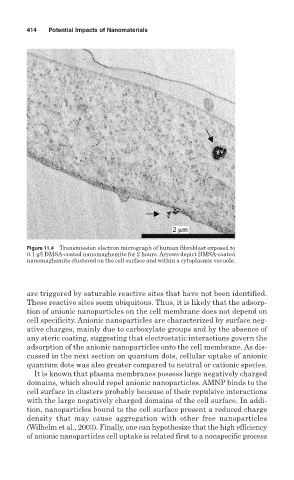Page 434 - Environmental Nanotechnology Applications and Impacts of Nanomaterials
P. 434
414 Potential Impacts of Nanomaterials
Figure 11.4 Transmission electron micrograph of human fibroblast exposed to
0.1 g/l DMSA-coated nanomaghemite for 2 hours. Arrows depict DMSA-coated
nanomaghemite clustered on the cell surface and within a cytoplasmic vacuole.
are triggered by saturable reactive sites that have not been identified.
These reactive sites seem ubiquitous. Thus, it is likely that the adsorp-
tion of anionic nanoparticles on the cell membrane does not depend on
cell specificity. Anionic nanoparticles are characterized by surface neg-
ative charges, mainly due to carboxylate groups and by the absence of
any steric coating, suggesting that electrostatic interactions govern the
adsorption of the anionic nanoparticles onto the cell membrane. As dis-
cussed in the next section on quantum dots, cellular uptake of anionic
quantum dots was also greater compared to neutral or cationic species.
It is known that plasma membranes possess large negatively charged
domains, which should repel anionic nanoparticles. AMNP binds to the
cell surface in clusters probably because of their repulsive interactions
with the large negatively charged domains of the cell surface. In addi-
tion, nanoparticles bound to the cell surface present a reduced charge
density that may cause aggregation with other free nanoparticles
(Wilhelm et al., 2003). Finally, one can hypothesize that the high efficiency
of anionic nanoparticles cell uptake is related first to a nonspecific process

